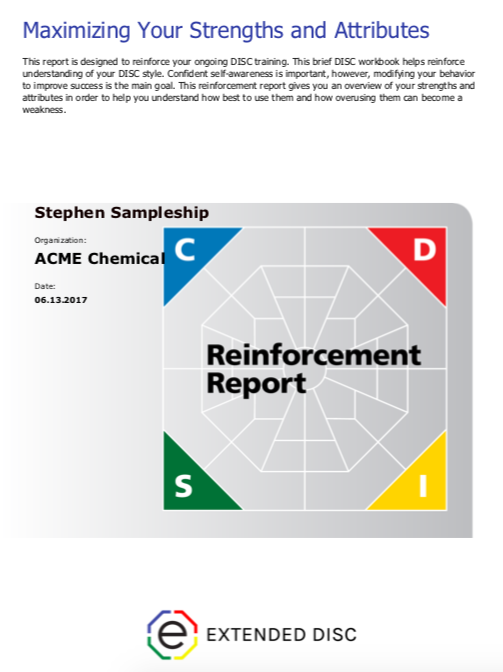Are you looking for different ways to reinforce your DISC trainings?
You’ve delivered another successful DISC session! Your clients left with a clearer understanding of how DISC can improve their daily interactions. They’re motivated and ready to put it into practice. Then, the momentum suddenly stops when they return to their daily routines. They find themselves thrown back into the pressures of client demands, fast approaching deadlines, and urgent emails. Their best intentions don’t end up translating into potential success.
DISC is a simple tool, but it works best when consistently practiced. The good news is that practice helps it become a habit and over time it will simply be a regular part of what you do. Experiencing improved interactions will further fuel the practice of DISC. However, getting started post-training can be a challenge. So, how can you help your clients consistently practice DISC after their sessions?
How Reinforcement Reports help you and your clients

There are very few of us who are able to conduct one-on-one ongoing reinforcement sessions with our clients. We are more likely to conduct one-time group trainings with limited or no opportunities for one-on-one sessions or additional sessions. Therefore, as trainers, we need to have a variety of reinforcement tools to offer our clients.
There are intensive, but highly effective, approaches for reinforcing DISC, includin focusing on leadership buy-in, and holding follow-up sessions. However, reinforcement can also be effective by focusing on simple, targeted self-awareness practice. In addition, flexible tools can help your clients strengthen their likelihood of using the tool by fitting it more easily into their already hectic schedules. They are more likely to practice the skills if the concepts are familiar and focused. As always, the end goal is to be self-aware and to practice adjustments consistently to improve communications, interactions, and ultimately relationships.
Your clients know the information in their DISC Assessment is valuable, but they may feel overwhelmed by it. These focused workbooks target a very specific area of their behavioral style so they won’t feel so overwhelmed, and thus, more likely to use the information. The Extended DISC® Reinforcement Reports are designed to reinforce your clients’ ongoing DISC practice.
Reinforcement Report options
 Each Reinforcement Report focuses on one to two sections of the Extended DISC® Assessment. These reports, based on your client’s DISC Profile, focuses on topics such as communication strategy, time management, handling pressure, decision-making, motivators, being a team member, and maximizing our strengths.
Each Reinforcement Report focuses on one to two sections of the Extended DISC® Assessment. These reports, based on your client’s DISC Profile, focuses on topics such as communication strategy, time management, handling pressure, decision-making, motivators, being a team member, and maximizing our strengths.
The clients review their own DISC data, which is already familiar to them from their DISC training. However, these reports focus on a concise area to develop and practice adjusting. The targeted questions, built into the reports, that help them in their development.
In addition, your clients won’t need to take any additional assessments, other than their initial Extended DISC® Questionnaire for their original DISC session. You can easily order Reinforcement Reports using the clients’ existing DISC results. You get to decide what areas your clients should focus on by choosing from multiple report options, and deciding the best timeline to present them.
Tips for using a Reinforcement Report
 Let’s say it’s been four weeks since the DISC session, and now you are ready to send out the first Reinforcement Report. Which one do you send? There is no set sequence, but the Maximizing Your Strengths and Attributes Report is a good one to start with. Clients love to read about their strengths (who doesn’t); it’s like a pat on the back! It targets your client’s behavioral strengths and attributes; how to use them, and how not to overuse them. Clients review their strengths and attributes to refresh and build conscious awareness. They also identify areas in which they have overused them. Remember, an overused strength or attribute can lead to potential trouble!
Let’s say it’s been four weeks since the DISC session, and now you are ready to send out the first Reinforcement Report. Which one do you send? There is no set sequence, but the Maximizing Your Strengths and Attributes Report is a good one to start with. Clients love to read about their strengths (who doesn’t); it’s like a pat on the back! It targets your client’s behavioral strengths and attributes; how to use them, and how not to overuse them. Clients review their strengths and attributes to refresh and build conscious awareness. They also identify areas in which they have overused them. Remember, an overused strength or attribute can lead to potential trouble!
Now they have an opportunity to develop a plan and practice ways to avoid overusing their strengths and attributes. The specific questions and exercises built into the workbook help them use their strengths and attributes more effectively. They can have some time to consciously practice one area, and then move on to other areas to build on their successes.
Helping your clients succeed using DISC
If you are sending out the report to your group, then it can become a topic of lunch room conversation, “hey, what strengths did you focus on in your reinforcement report?” It may even be an opportunity for them to coach each other and build the DISC into their everyday language. More importantly, it’s a personalized reminder and encouragement to practice behavioral modification.
Self-awareness is important in understanding how we prefer to do things, but what creates long term success is knowing when to adjust our behaviors. We are only in control of ourselves in any given interaction; we cannot force the other person to adjust. If we are able to provide clients with relevant information about themselves, and help them develop practical steps in how to adjust, then they are more likely to adjust effectively, and in the end that’s what it’s all about.
Contact us at CustomerService@ExtendedDISC.org to learn more!
